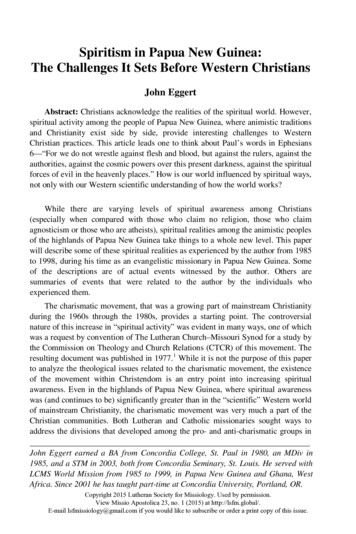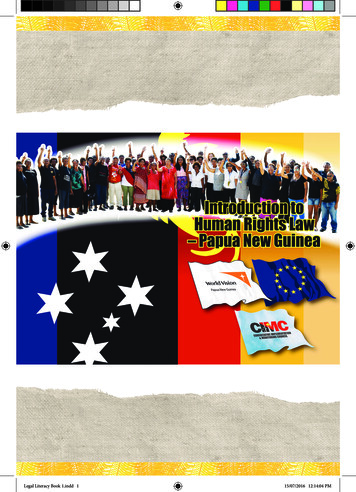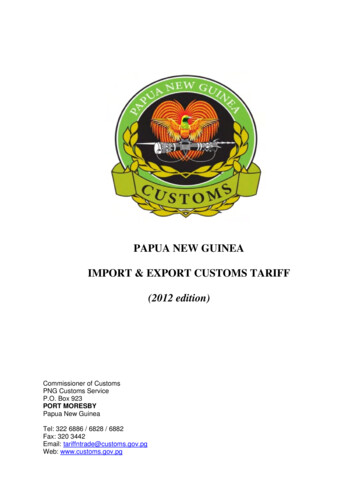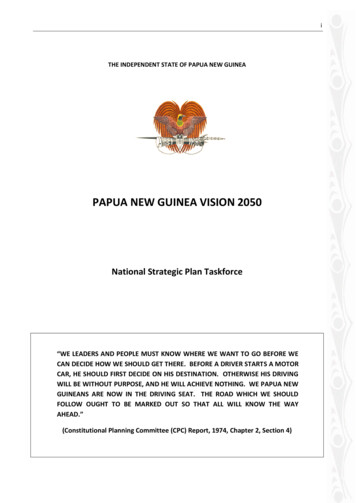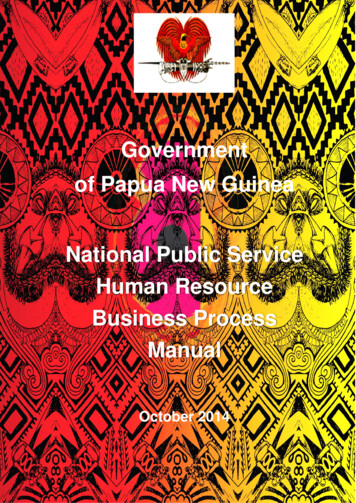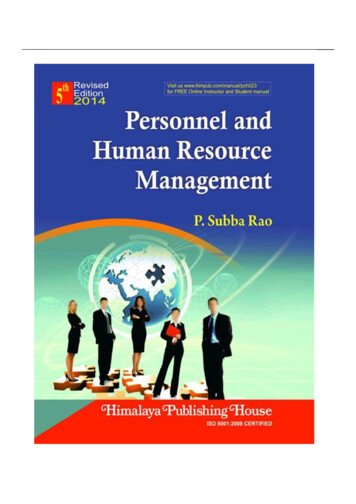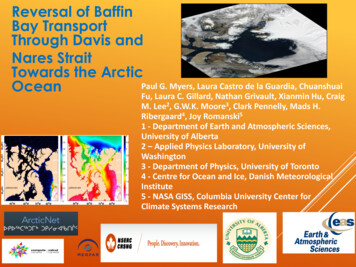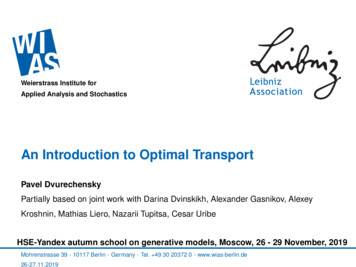
Transcription
Local transport solutionsin Papua New Guineaoptions for animal power andintermediate means of transportPaul StarkeyReport of appraisal mission2006
The opinions expressed in this report are those of the author.They do not necessarily reflect the views of theOffice of Rural Development of theIndependent State of Papua New Guineafor whom the document was prepared.Cover photographs Paul StarkeyPaul Starkey (2006): Local transport solutions in Papua New Guinea: Page 2
THE INDEPENDENT STATE OFPAPUA NEW GUINEAOFFICE OF RURAL DEVELOPMENTLocal transport solutionsin Papua New Guineaoptions for animal power andintermediate means of transportReport prepared byPaul StarkeyRural Transport ConsultantAnimal Traction Development and University of Reading64 Northcourt Avenue, Reading RG2 7HQ, UKTel: 44 (0) 118-987 2152 Fax: 44 (0)118-931 4525Email: paulstarkey@animaltraction.com and p.h.starkey@reading.ac.ukWebsites: http://www.animaltraction.com, http://www.animaltraction.netJuly 2006Paul Starkey (2006): Local transport solutions in Papua New Guinea: Page 3
Acronyms, abbreviations and exchange VPNGSSATPUKUnitechUPNGUSUSDVSOAsia Development BankAfrica, Caribbean and PacificAssociation Français des Voluntaires du Progrès (French NGO)Animal Traction Network for Eastern and Southern AfricaAustralian Dollar AUD 1 2.2 PGK (approx) in June 2006Australian Government’s Overseas Aid ProgramCoffee Industry CorporationCentre for Agricultural and Rural Cooperation, The NetherlandsDepartment for International Development, UKEditorfor exampleEuropean UnionEuro EUR 1 3.7 PGK (approx) in June 2006Great Britain Pound (UK Sterling). GBP 1 5.2 PGK (approx) in June 2006International Forum for Rural Transport and Development (Secretariat in London, UK)that is to sayIntermediate means of transportInternational Standard Book NumberkilogramkilometreLutheran Development ServiceA conferred honour (literally Member of the British Empire)Member of ParliamentNational Agricultural Research Institutenon-governmental organisationNational Research InstituteA conferred honour (literally Order of the British Empire)Office of Rural Developmentpage(s)Papua New Guinea Kina1 Kina (approx) USD 0.35 EUR 0.27 AUD 0.46 GBP 0.19 in June 2006Public motor vehiclePapua New GuineaSub-Saharan Africa Transport Policy Program, World Bank, Washington DC, USAUnited Kingdom (of Great Britain and Northern Ireland)University of TechnologyUniversity of Papua New GuineaUnited States of AmericaUnited States Dollar USD 1 2.9 PGK (approx) in June 2006Voluntary Service Overseas (British NGO)Paul Starkey (2006): Local transport solutions in Papua New Guinea: Page 4
ContentsAcronyms, abbreviations and exchange rates.4Acknowledgements.61: Summary .72: Planning and implementing this study .9Background .9Terms of Reference.9Implementation of the study .10Reporting.103. Introducing local transport solutions and animal power.11Inadequate rural transport in Papua New Guinea .11Local transport solutions.11Examples of successful promotion of local transport solutions.12Lessons from the successful promotion of local transport solutions .144. Appraisal of constraints and experiences in Papua New Guinea .15Transport problems in Papua New Guinea .15History of animal power in Papua New Guinea .16Lessons from animal power in Papua New Guinea .21The use of bicycles and motorcycles in Papua New Guinea .22The use of other transport technologies in Papua New Guinea .235. Analysis of opportunities and risks .24Technologies suitable for promotion in Papua New Guinea .24Possible reasons for caution and for optimism .306. Policy implications .33Policy issues to be addressed .337. Suggested strategies .35Overall strategy for promotion.358. Some specific suggestions of ways forward .41General.41Networking, workshops and visits.41Projects and initiatives to be developed.43‘Baseline’ estimates and surveys .469. Conclusions.4710. References and bibliography .4811. Annexes .49Annex 1: Terms of Reference .49Annex 2: Outline of itinerary.50Annex 3: Some network contacts .52Paul Starkey (2006): Local transport solutions in Papua New Guinea: Page 5
AcknowledgementsThe author of this report wishes to thank the many people who contributed to theplanning and implementation of the appraisal visit and to the contents of this report.The inspiration for this work, as well as its planning and facilitation was theHonourable Jamie Maxtone-Graham MBE, MP, Member for Anglimp South Waghi.Having understood the transport problems that rural people face, he used the internetto look for solutions to the problems in Papua New Guinea and came across manyreferences to the work of Professor Paul Starkey. Following email contacts and ameeting in London, the aims and objectives of an appraisal visit were agreed.The visit was subsequently arranged and funded, with support from Hon ArthurSomaire, Paul Sai’i, Director of the Office of Rural Development, Valentine Kambori,Secretary, Department of National Planning and Monitoring and David GordonMacleod, the British High Commissioner.The author is very grateful for the opportunity and privilege of visiting Papua NewGuinea and learning from many people in the government, the civil service, researchinstitutions, NGOs, the private sector, aid agencies and many rural women and men.Staff of the Office of Rural Development provided planning and logistical support,including Paul Sai’i (Director), Kelly Lovuru (Deputy Director), Vaia Vai’i (PolicyAdvisor) and Kino Wenge (Consultant). Many other people in the capital city,provincial towns and in rural areas also provided advice, assistance, logistical supportand hospitality.Particular thanks go to the very many people who were interviewed and provided theinformation that is central to this report. These included Politicians (Prime Minister,Deputy Prime Minister, Minister for Health, Minister for Community Development,several Members of Parliament for remote constituencies), Governmentadministration (Planning and Monitoring, Rural Development, Agriculture andLivestock, Transport, Health, Education, Community Development), Provincialadministrations (Morobe, Eastern Highlands, Chimbu, Western Highlands), Researchorganisations and universities (NARI, NRI, UPNG, Unitech), Aid agencies anddiplomatic representatives (ADB, AusAid, British High Commission, EuropeanUnion, French Embassy, World Bank), Private sector (ATProjects, Ramu Beef, RamuSugar, Rural Industry Council) and NGOs (Catholic Church Dioceses, CommunityBased Health and Development, Lutheran Development Service, VSO).About 1000 people contributed through their participation at seminars and thenational workshop. Special appreciation goes to Stanley Peng and Jake Ainga fromJimmi. These two farmers, like so many others, have a huge problem transporting andselling coffee in the absence of PMVs and local transport solutions. After they heardabout the Banz seminar on the radio, they walked for two whole days in order toattend. This example of rural transport problems and the enthusiasm of rural peoplefor local transport solutions made an unforgettable impression on the author. To these,and to everyone who assisted this work, a very big ‘thank you’.Paul StarkeyReading, July 2006Paul Starkey (2006): Local transport solutions in Papua New Guinea: Page 6
1: SummaryVery many rural women, men and children in Papua New Guinea face transport problems.Two million people live more than four hours walk from the nearest road with public motorvehicles (PMVs). Their only way of reaching towns (and their hospitals, shops and markets)is to walk to the road, carrying their burdens. Lack of rural transport reduces schoolattendance, access to health care, incomes and agricultural production. In most countries inthe world, people benefit from local transport solutions, such as riding or pack animals, carts,bicycles and motorcycles. In Papua New Guinea the use of such intermediate means oftransport is exceptionally low, there is a ‘missing middle’ in rural transport. Experience fromother countries suggests that it is possible to promote the use of animal traction andintermediate means of transport, and that adoption can be rapid and the benefits are great.Missionaries, plantations and military forces have successfully used work animals for theirown purposes in Papua New Guinea, proving the technology can work. There are breedingferal herds of horses, buffaloes and cattle showing animals can thrive. Rural people now seethat such animals could solve some transport problems, provided there were sustainable andaffordable supplies and support services.It is difficult to adopt transport technologies when they are scarce, expensive and have nosupport services (training, repairs, replacements). Supply and support services do not developspontaneously where there is no apparent demand. Papua New Guinea is in such a viciouscircle in terms of bicycles, motorcycles and animal power. There is no ‘critical mass’ of usersto justify competing suppliers. If both supply and demand could be stimulated (‘priming thepump’), a virtuous spiral of growing demand and increasing support services could develop,making subsequent adoption easier. Successful technology promotion depends on creatingthat ‘critical mass’ of users, by concentrating initial efforts within a suitable target area.It is recommended that the Government of Papua New Guinea makes a policy decision toaddress the ‘missing middle’ in rural transport, encouraging intermediate means of transportthat can reduce the burden of walking and carrying. Greater use of local transport solutionsshould reduce poverty, increase access to health care and education and increase agriculturalproduction and marketing. All relevant government ministries and institutions shouldformulate strategies to assist the process in their technical domains.The long-term aim should be for widespread and safe use by women, men and children of arange of transport technologies. These should be appropriate to the users and the localenvironment and should be supplied and supported by the private sector. They may includebicycles, motorcycles, handcarts, ox carts, buffalo carts, riding and pack horses and packdonkeys and mules. Some animals can also be used for soil tillage and road maintenance.In the short term, promotional efforts (supported by the government and aid agencies) will berequired. Efforts should be concentrated and targeted to create the necessary critical mass ofusers and suppliers of particular technologies in suitable areas. Baseline survey estimates willbe needed to measure progress.A devolved system of many linked projects undertaken by different organisations is likely tobe effective and have a wide impact. An independent network should be established tocoordinate initiatives, encourage information exchange and learn from experiences, withinPapua New Guinea, the Pacific region and other parts of the world.Paul Starkey (2006): Local transport solutions in Papua New Guinea: Page 7
Paul Starkey (2006): Local transport solutions in Papua New Guinea: Page 8
2: Planning and implementing this studyBackgroundThe Honourable Jamie Maxtone-Graham MBE, MP is Member for Anglimp South Waghi.He remembers as a child, seeing the burdens carried by women, often in the traditional‘bilum’ bags. He recalls that in the evenings the exhausted women would rub each other’sbacks with a special plant leaf that stung the back but relieved the deep pain. The burden ofrural women, and the traditional remedy continue to this day, and Hon Jamie MaxtoneGraham resolved to see if the transport problem could be solved through the use of animalpower.Hon Jamie Maxtone-Graham used the internet to research the issue and looked for solutionsto the problems in Papua New Guinea. He came across many references to the work andpublications of the present author, Paul Starkey, an international consultant concerned withimproving rural transport systems and sustainable animal power. In a professional careerspanning 35 years, Paul Starkey has directed animal traction research, extension and trainingat a national level and helped to develop effective international networks for sharingknowledge and experiences. He has visited more than 125 countries in Africa, Asia, LatinAmerica and Europe, with consultancy work involving networking skills, a farming systemsperspective and participatory methods. He has been appointed a Visiting Professor at theUniversity of Reading and Chairman of the International Forum for Rural Transport andDevelopment. His work has been based on a worldwide vision that encompasses lessons frompast experiences, the present priorities of all stakeholders and the needs of economic andsocial development.Hon Jamie Maxtone-Graham invited Paul Starkey to visit Papua New Guinea to advise onrealistic animal power and transport options that can benefit the people of Papua NewGuinea. With cooperation from Hon Arthur Somaire, Paul Sai’i, Director of the Office ofRural Development and Valentine Kambori, Secretary, Department of National Planning andMonitoring and David Gordon-Macleod, the British High Commissioner, Hon JamieMaxtone-Graham was able to make the necessary arrangements.Terms of ReferenceThe Office of Rural Development prepared the contract and the full terms of reference of thisstudy are included in Annex 1. They envisaged Paul Starkey would:o Hold initial discussions with institutional stakeholders (government, aid agencies, NGOs)concerning the visit, its objectives and proposed itinerary.o Visit the Highlands and other rural areas and discuss with a range of rural stakeholdersthe current situation relating to rural transport services and intermediate means oftransport and the potential for animal power.o Discuss with relevant institutional stakeholders possible options for interventions thatcould improve the existing situation.o Prepare a PowerPoint presentation relating to the potential for animal power andintermediate means of transport in Papua New Guinea and participate in seminars.o Prepare a brief report summarising the visit, findings and recommendations, with someoutline suggestions for possible follow-up actions.Paul Starkey (2006): Local transport solutions in Papua New Guinea: Page 9
Implementation of the studyPaul Starkey visited Papua New Guinea from 12 May to 8 June 2006. During this time he haddiscussions with a wide range of stakeholders, including:o Politicians (Prime Minister, Deputy Prime Minister, Minister for Health, Minister forCommunity Development, several Members of Parliament for remote constituencies)o Central government administration (Planning and Monitoring, Rural Development,Agriculture and Livestock, Transport, Health, Education, Community Development)o Provincial and local administration (Morobe, Eastern Highlands, Chimbu, WesternHighlands)o Research organisations and universities (NARI, NRI, UPNG, Unitech)o Aid agencies and diplomatic representatives (ADB, AusAid, British High Commission,European Union, French Embassy, World Bank)o Private sector (ATProjects, Ramu Beef, Ramu Sugar, Rural Industry Council)o NGOs (Catholic Church Dioceses, Community Based Health and Development, LutheranDevelopment Service, VSO).In addition to meetings held in the National Capital District, Paul Starkey travelled to meetstakeholders in six rural provinces. This involved flying to remote communities in CentralProvince (Woitape, Ononge, Tapini, Fane), Gulf Province (Kanabea, Kaintiba, Kerema),Eastern Highlands Province (Menyamya) and Morobe Province (Kabwum, Wasu). It alsoinvolved driving to communities and towns in Central Province (Porebada, Kanosia), MorobeProvince (Lae, Markham Valley, Ramu), Eastern Highlands Province (Kainantu, Aiyura,Goroka), Chimbu Province (Kundiawa) and Western Highland Province (Mount Hagen,Minj, Domil, Banz). While visits to other provinces had been planned, lack of resources andpressure of time made this impracticable. A summary of the itinerary is provided in Annex 2.During his visits, Paul Starkey gave seminars with PowerPoint presentations and discussionsat Lae (NARI), Aiyura (NARI), Goroka, Kundiawa, Minj, Domil, Banz and Mount Hagen.The visit culminated in a national seminar at Port Morsely. About 1000 people participated inthese seminars. In addition, the consultant with Hon Jamie Maxtone-Graham took part inthree radio interviews to discuss the issues of animal power, rural transport and localtransport solutions.ReportingPrior to his departure, the author prepared a 4–page policy brief, that summarised the keyissues and lessons emerging, and the main policy and strategy recommendations. He alsoprovided Hon Jamie Maxtone-Graham with copies of the final PowerPoint presentations.This present document provides a more detailed summary of the visit, highlighting key issuesand providing some specific suggestions for the future. As envisaged in the Terms ofReference, this document concentrates on land transport. There are also aquatic intermediatemeans of transport that provide coastal transport and operate on waterways. Small boatspowered by paddles, poles, sails or small motors complement larger-scale water transport.During this visit, emphasis was place on land transport, and there are only passing referencesto water transport, even though this is known to be extremely important in some provinces. Inorder to make this document convenient for email transmission, there has been little use ofphotographs in this particular report.Paul Starkey (2006): Local transport solutions in Papua New Guinea: Page 10
3. Introducing local transport solutions and animal powerInadequate rural transport in Papua New GuineaInadequate transport and accessibility cause poverty and constrain rural development. In ruralPapua New Guinea, much transport involves people walking and carrying burdens. Publicmotor vehicles (PMVs) are often only available on the main roads, and most people do notlive close to main roads. Because motor transport is unavailable or too expensive, very manywomen and men are excluded from selling produce at a fair price and may be unable toactively participate in the national economy. Access to health care and education is alsodifficult because motorised transport is unavailable and there are no easy alternatives towalking. Understanding existing rural transport constraints and options for overcoming themis a precondition for appropriate policy action by national and decentralised governments andall government services concerned with health, education, welfare and economic and socialdevelopment.Local transport solutionsIn many other countries in the world, between walking/carrying and large-scale motorisedtransport (PMVs) there is a wide range of land-based intermediate means of transportavailable. These increase transport capacity and reduce drudgery at relatively low cost,solving local transport problems. Local transport solutions include handcarts, bicycles,tricycles, animal-powered transport, motorcycles and power tiller trailers. These technologiesare not yet well developed in Papua New Guinea, and there is much scope for increasing anddeveloping them. For example, in other countries, bicycles empower rural women and men,increasing their transport efficiency at an affordable cost. In some parts of Papua New Guineabicycles are really important, but in most areas they are not widely used being unavailable,unaffordable and/or unappreciated. In some countries, motorcycle taxis provide much neededtransport services, while providing important rural employment. Such services do not yetexist in Papua New Guinea.A step forward, benefiting rural women, men and childrenLocal transport solutions are used in appropriate situations in industrialised countries anddeveloping countries. They are definitely not a step backwards from ‘modern’ transport. Theyshould be an integral component of all modern transport systems, and represent an importantstep forward from the constraints of walking and carrying.Local transport solutions complement motorised transport systems, by providing convenientand affordable transport to nearby farms, shops and services. For more isolated people, theyprovide crucial links to distant markets, education and health facilities. When wellestablished within societies, local transport solutions are generally affordable and sustainable,environmentally friendly and offer significant benefits to women.Local transport solutions reduce the drudgery, save time and increase the efficiency of ruralwomen, men and children: for example, using a bicycle, pack animal or cart, a painful 15 kgback load can be replaced by much larger load (80-120 kg) transported with more ease andspeed.Paul Starkey (2006): Local transport solutions in Papua New Guinea: Page 11
Potential for animal powerAnimal power is an appropriate, affordable and sustainable technology for agriculture andtransport that is widely used in the world and is increasing in many countries. It has alreadyproved technically successful in many locations in Papua New Guinea with horses, packmules, donkeys, oxen and buffaloes all having played locally important roles in the twentiethcentury for missionaries, armies and large-scale agricultural enterprises. However, it appearsthat people have only recently looked in a broad and strategic way at the potential for animalpower to help the women and men in remote areas to improve their livelihoods.Examples of successful promotion of local transport solutionsLocal transport solutions are generally owned by individuals and supplied and maintained bythe private sector. Where intermediate means of transport are widely adopted and wellestablished, the private sector (formal or informal) supplies and maintains them within acompetitive market. However, such private markets do not always arise spontaneously (as isthe case in Papua New Guinea). This may be because of the lack of awareness of thetechnologies and their utility for rural development and the absence of nearby examples tocopy. There is a need to create a market, providing affordable supplies and stimulating ademand. In appropriate circumstances, rural development agencies (government services,projects, NGOs) can work with both potential users and potential suppliers to start such amarket. Assuming the technology has economic and social benefits, once a ‘critical mass’ ofsuppliers and users has developed, the market can continue without further intervention. Thedevelopment agencies need to ‘prime the pump’ to help create that sustainable ‘critical mass’.There have been many recent examples from around the world where governments, NGOsand donor-assisted projects have done just this. They have facilitated the adoption ofintermediate means of transport. This has led to increased production and local economicgrowth and much better access to markets and services. Once the local market forintermediate means of transport has become established, private sector services have beenable to maintain it, without further project or NGO intervention.Examples of animals, carts and bicycles promoted in West AfricaIn the early 1950s, farmers in The Gambia did not use oxen, donkeys or horses. Thegovernment started a programme to introduce animal traction. This involved training peoplewho were unfamiliar with large animals, as well as ensuring supplies of animals andequipment and credit to purchase them. Today, all three types of animal are widely used forfarming and for transport. Animal power use is now probably found in all villages in TheGambia. Animal traction is now widely considered to be a normal and ‘traditional’ practice(Starkey, 1988).In Senegal, in the 1960s, there were very few local transport solutions. Most rural transportinvolved walking and head-loading around the villages and to access the main roads wherethere were some motor transport services (PMVs). The government launched an agriculturalcredit programme that helped people to purchase carts and soil tillage implements made by aprivate factory. Carts pulled by horses, donkeys and oxen became very popular, and within afew years, there was a ‘critical mass’ of suppliers, users and repairers in many parts of thecountry. Within 18 years, 130,000 carts were sold, and local transport solutions became arecognised and important part of rural transport (Starkey, 2001).Paul Starkey (2006): Local transport solutions in Papua New Guinea: Page 12
In Western Burkina Faso, there were no donkeys at all prior to the 1980s and no one wasused to managing them. In about 1981, a farmer brought in one donkey and started to use itwith a cart. People copied the idea, and the local cotton-producing company started to givecredit for the purchase of donkeys and carts. Within twenty years, almost all households inthe region owned and used donkey carts.In Burkina Faso in the 1970s, two bicycle factories were established and an assembly plantstarted to assemble lightweight motorcycles. These were government backed privateinitiatives and all proved very successful. Thanks to reliable local supplies and a flat terrain, acritical mass of bicycle and motorcycle users developed. Both motorcycles and bicycles arenow widely used in towns and rural areas. Men and women own and use them for personalmobility and great variety of social and economic purposes. In most areas there is more thanone bicycle owned per family. People find investment in bicycles and motorcycles profitable,and probably more than one hundred million dollars has been invested in these forms oftransport since the initiative started. In the past year, local production has largely ceased dueto competition from low cost Chinese imports (Starkey, 2006).Examples from Eastern and Southern AfricaThere had been no tradition of animal power in the remote North-Western Province ofZambia, when a development project started operations in about 1978. The rural populationdepended on smallholder farming and agricultural transport and marketing was a keyconstraint. There were few cattle and no carts, but the project started a training programmeand a workshop that made carts. The ox carts proved popular and their adoption, assisted byextension and credit, was quite rapid. By 1990, about one in ten households owned a cart.The carts facilitated marketing and production and incomes increased stimulating economicdevelopment and growth in the area. This growth, in turn, stimulated further demand for localtransport solutions (Starkey, 2001).At Makete, in Southwest Tanzania, transport was a key problem and in 1986 a ruraldevelopment project discussed possible solutions with local stakeholders. One suggestionwas the use of donkeys, but there were only three donkeys in the whole area and almost noexperience of using donkeys. The project worked with local people to bring donkeys into thearea and train people to use them. By 1994, there were 50 in use. Initial cost-benefitcalculation suggested the use of donkeys was highly beneficial, and higher than that ofconstructing feeder roads (Sieber, 2004). Since then the donkeys have been regularly usedand have been gradually increasing in numbers, with about 300 in use in 2005.In Dar e
attend. This example of rural transport problems and the enthusiasm of rural people for local transport solutions made an unforgettable impression on the author. To these, and to everyone who assisted this work, a very big 'thank you'. Paul Starkey Reading, July 2006 Paul Starkey (2006): Local transport solutions in Papua New Guinea: Page 6
